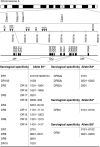HLA-DR and -DQ phenotypes in inflammatory bowel disease: a meta-analysis
- PMID: 10446108
- PMCID: PMC1727649
- DOI: 10.1136/gut.45.3.395
HLA-DR and -DQ phenotypes in inflammatory bowel disease: a meta-analysis
Abstract
Background: Susceptibility to inflammatory bowel disease (IBD) is partially genetically determined and the HLA class II genes are candidates for a role in genetic susceptibility to IBD, because their products play a central role in the immune response. Multiple studies have reported associations between HLA-DR or -DQ phenotypes and either ulcerative colitis or Crohn's disease, but much of the data are still controversial.
Aims: To estimate overall associations between HLA class II phenotypes and IBD, and to establish the relative risk conferred by HLA-DR and -DQ phenotypes by meta-analysis.
Methods: Medline was searched for publications reporting on the relation between IBD and HLA class II phenotypes. Raw data were extracted by recalculating the number of phenotypes or the number of alleles of the main antigens. Odds ratios and confidence intervals were calculated according to the Mantel-Haenszel method.
Results: DR2, DR9, and DRB1*0103 were positively associated with ulcerative colitis, and a negative association was found for DR4 and ulcerative colitis. For Crohn's disease a positive association was found with DR7, DRB3*0301, and DQ4 and a negative association with DR2 and DR3.
Conclusions: Both ulcerative colitis and Crohn's disease are associated with specific HLA class II phenotypes. Further analysis of these phenotypes and subgroup analysis may elucidate how these alleles contribute to susceptibility to IBD.
Figures



References
Publication types
MeSH terms
Substances
LinkOut - more resources
Full Text Sources
Other Literature Sources
Medical
Research Materials
